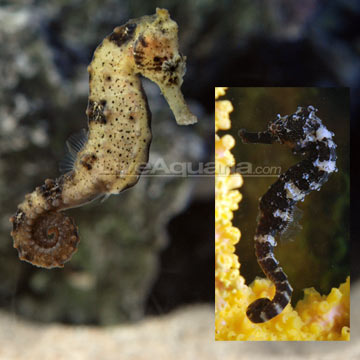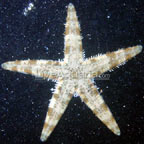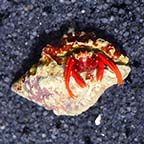

Additional locales and sizes may be available!
Additional locales and sizes may be available! Email me when availableQuick Stats
What do these Quick Stats mean? Click here for more information
What do these Quick Stats mean? Click here for more information
Overview
Like other seahorses, Hippocampus cf kuda has a stunning body form that harkens bygone ages. Small Tank Raised Estuary seahorses can range in coloration from all black with white markings on their face with a yellow banded tail, to being all cream or yellow in coloration. Adult males of this species are usually drabber than their female counterparts, and display small dark sports over their body. Adult females are oftentimes all black or plain yellow. The coloration may change in the aquarium and is highly dependent on the colors of its environment.
The Estuary Seahorse does best when kept as either a mated pair, or with a small group of its own kind in a species-only aquarium of 55 gallons or larger. Taller aquariums are ideal and good water circulation is most important. The Estuary Seahorse will get along well with small, shy fish such as gobies, dragonets, and dartfish. Aggressive, territorial, or fast-moving fish do not make good companions and should be avoided as possible tankmates, as fast, aggressive fish will out-compete the Seahorses for food. The Estuary Seahorse spends most of its time clinging to seagrass and rocks with its prehensile tail rather than swimming.
When ready to mate, the male Estuary Seahorse will impress the female with its dramatic color changes, energetic pouch displays, and lots of graceful dancing. If receptive, the future mate will entwine tails, dance, and promenade with the male and then deposit as many as 600 eggs in the male pouch. About 14 days later, the male will give birth to between 50-400 offspring.
When first introduced into the aquarium, enriched live artemia may be needed to entice the seahorse to start feeding again. Once feeding properly offer small quantities of enriched frozen artemia and small mysis shrimp several times per day to maintain these fishes in top health, as they are very slow and methodical feeders. The Estuary Seahorse will also feed upon live amphipods and other small crustaceans found in live rock so a well established aquarium is needed to provide this natural occurring live food source.
Looking for the best food to feed your Seahorses? We recommend AlgaGen Tisbe biminiensis.
Approximate Purchase Size: Small; 1" to 2" Medium; 2" to 4"











